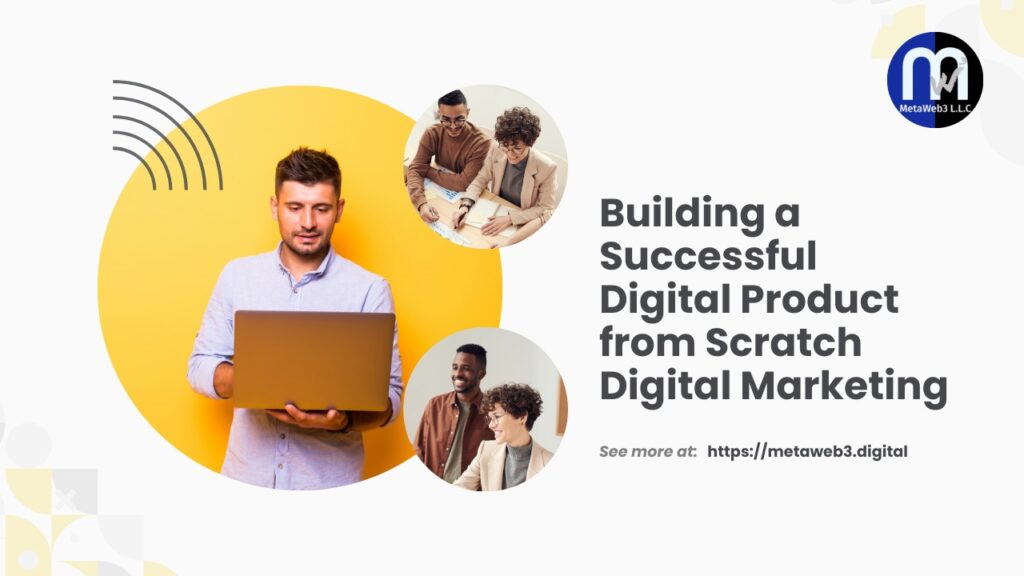Building a Successful Digital product from Scratch Digital Marketing

Table of Contents
Building a digital product from scratch can be a daunting task, but with the right approach, it can also be incredibly rewarding. In this blog post, we will explore the key steps to creating a profitable digital product, from validating your product idea to monetizing your digital goods.
7 effective methods to build a successful Digital Product
1. Analyze the Product Idea
The first step in creating a digital product is to authenticate your product idea. This means identifying a problem or pain point that your potential customers are facing and then finding a way to solve it. One way to do this is by conducting market product research and identifying a niche market that is related to your product. For example, if you want to sell a digital course on how to improve public speaking, you wish to conduct research on the types of people who need help with public speaking, what they’re struggling with, and what solutions are currently available to them.
2. Understanding the Target Market
Once you have a clear understanding of your target market and the problem you’re trying to solve, you can begin to develop your concept. This is where you’ll want to start thinking about what type of digital product you want to create. Will it be an online course, an ebook, software, or a membership site? There are many different digital products you can create and sell, and the best one for you will depend on your niche and the solution you’re offering.
3. Minimum Viable Product(MVP)
After you have a product, it’s time to create a minimum viable product. An MVP is a basic version of your product that you can use to test the market and gather user feedback. This could be a prototype or an online course that you can sell to a small group of potential customers. This is a crucial step because it allows you to validate your product before you invest a lot of time and money into creating a full-featured product.
4. Build an Audience
Once you have an MVP, it’s time to build an audience. One of the best ways to do this is by creating an email list and reaching out to influencers in your niche market. This will help you promote your product and increase traffic to your website. Building an email list is important because it gives you a direct line of communication with your customers, which you can use to promote your product, gather feedback, and build relationships.
5. Ready to Sell Product
Once you have an audience, it’s time to sell a digital product. This could be through e-commerce, digital downloads, or even creating a physical product related to your digital product. The key is to find a way to sell your product that aligns with your niche market and the needs of your customers. For example, if your digital product is an online course, you can monetize it by selling access to the course, offering a subscription service, or creating a membership site.
6. Launch the Digital Product
Once you have a monetization strategy in place, it’s time to launch your digital product. This is where you’ll want to start promoting your product to your audience and driving traffic to your website. This is a crucial step because it’s what will determine the success of your product. You’ll choose to make sure that you have a clear message, a compelling offer, and a call to action that will encourage people to buy your product.
7. User's Feedback
Once your product is launched, it’s important to continue to improve it based on user feedback and market research. This means conducting regular product reviews, gathering data on your product’s performance, and using it to make informed decisions. This is a crucial step because it allows you to continuously improve your product and make it even more valuable to your customers.
5 Simple Steps to Make Profitable Digital Products
1. Validate Your Product Idea
Before you begin to create digital products, it is crucial to validate your idea. Conduct market research to determine the size of the potential market and identify your target audience. This will give you valuable insights into what customers want, which will help you to create a product that solves a specific pain point and meets their needs. By validating your idea, you’ll be able to ensure that there is a market for your product and that it will be profitable.
2. Start with a Minimum Viable Product (MVP)
Once you’ve confirmed your idea, it’s time to start building your product. The key to building a digital product from scrape is to start with a minimum viable product (MVP). An MVP is a version of your product that includes only the core features that are necessary for it to be functional. This allows you to get feedback from customers early on, which will help you to iterate and improve your product as you go.
3. Focus on Your Core Value Proposition
As you continue to build and improve your product, it’s important to stay focused on your core value proposition. This is the key benefit that your product provides to customers. By staying focused on your core value proposition, you’ll be able to create a product that stands out in the market and is unique compared to competitors.
4. Make Sure Your Product is User-Friendly
Another important step is to build a digital product is to make sure that your product is user-friendly. This means that it should be easy to use, easy to understand, and easy to navigate. To ensure that your product is user-friendly, you should conduct user testing throughout the development process. This will give you valuable insights into how customers interact with your product and where improvements can be made.
5. Have a Solid Marketing and Distribution Strategy
Finally, it’s important to have a solid marketing and distribution strategy in place. Once your product is built, you’ll need to get the word out about it. This can be done through a variety of channels such as social media, content marketing, and paid advertising. Building an email list and promoting your product through influences and affiliate marketing can also be effective ways to reach your target audience. It’s also important to have a strong distribution strategy in place so that you can reach as many customers as possible and sell your digital product online.
Understanding the Types of Digital Products
You can create
When it comes to creating a digital product, there are many different options available to you. Understanding the digital products you can create will help you make informed decisions about what to create and how to sell them. Some popular types of digital products include:
- Online courses: These can be in the form of video, audio, or written content and can teach anything from a specific skill to a broader topic.
- E-books: E-books are digital versions of traditional books and can be sold as PDFs or through platforms like Amazon Kindle.
- Software: This can include everything from mobile apps to desktop software and can be sold as a one-time purchase or on a subscription basis.
- Membership sites: These are websites that offer exclusive content, resources, or community access to members who pay a recurring fee.
- Digital downloads: This can include anything from music and videos to stock photos and graphics.
- Online consultation and coaching: This can include one-on-one sessions, group sessions, or pre-recorded sessions.
- Plugins and themes: This can include the website and other digital platforms.
- Virtual and augmented reality experiences: This can include games and other interactive experiences that can be accessed through a VR headset or smartphone app.
- Podcasts: These can be audio recordings that can be listened to on-demand.
- Live webinars: This can include live-streamed or pre-recorded webinars that can be accessed through the internet.
The digital product you choose to create will depend on your niche, target audience, and the solution you’re offering. It’s important to take the time to research and understand the different digital products available, so you can make an informed decision about what to create and how to sell it.
Developing a Product Concept That Solves a Problem
Developing a product concept that solves a problem is a crucial step in creating a successful digital product. This involves identifying a problem or pain point that your potential customers are facing and then creating a solution that addresses that problem.
To start, it’s important to conduct market research and understand your target audience. This can include conducting surveys, interviews, or focus groups to gather information about the problems your customers are facing. You can also look at online forums and social media groups to see what people are talking about in your niche.
Once you have a clear understanding of the problems your target audience is facing, you can begin to develop a product concept that addresses those problems. This is where you’ll start thinking about what type of digital product you want to create, and what features and benefits it will have. For example, if you’re creating a digital product to help people improve their public speaking skills, your product concept could be an online course that teaches specific strategies and techniques for overcoming stage fright and delivering powerful presentations.
Conclusion
Lastly, you will want to continually improve your product based on user feedback and market research. This means conducting regular product reviews, gathering data on your product’s performance, and using it to make informed decisions.
Creating a digital product from scrape takes time, effort, and dedication, but with the right approach, it can also be incredibly rewarding. By validating your product, creating an MVP, building an audience, monetizing your product, and continually improving it, you can turn your digital product into a profitable business.


